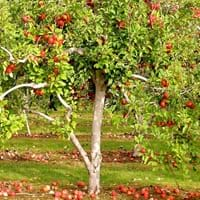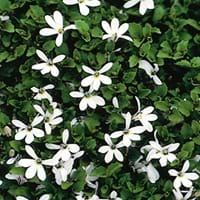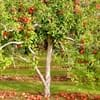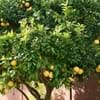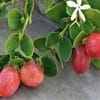Life Span
Perennial
Perennial
Type
Flowering Plants, Fruits, Trees
Perennial
Origin
Central Asia
Australia, New Zealand
Types
Aceymac apple, Bailey Sweet apple, Dabinett apple, Nehou apple
White Star Creeper, 'Alba' Super Star Creeper, 'County Park' Dark Blue Star Creeper, 'Little Star Creeper
Habitat
Hillside
gardens, gully slopes, Terrestrial, Tropical areas
USDA Hardiness Zone
5-8
5-8
Sunset Zone
A1, A2, A3, 8, 9, 10, 11, 12, 13, 14, 15, 16, 17, 18, 19, 20, 21, 22, 23, 24
4, 5, 6, 7, 8, 9, 14, 15, 16, 17, 18, 19, 20, 21, 22, 23, 24
Habit
Oval or Rounded
Mat-forming
Flower Color
White
Light Blue
Flower Color Modifier
Not Available
Bicolor
Fruit Color
Green, Red
Non Fruiting Plant
Leaf Color in Spring
Dark Green
Green
Leaf Color in Summer
Green
Green
Leaf Color in Fall
Brown, Green, Light Yellow
Green
Leaf Color in Winter
Not Available
Green
Plant Season
Spring
Spring, Summer, Fall
Sunlight
Full Sun, Partial shade
Full Sun, Partial Sun, Partial shade
Type of Soil
Loamy
Clay, Loam
The pH of Soil
Neutral
Acidic, Neutral, Alkaline
Soil Drainage
Well drained
Average
Bloom Time
Fall, Summer
Late Spring, Early Summer, Summer, Late Summer
Tolerances
Drought
Wet Site
Where to Plant?
Ground
Container, Ground
How to Plant?
Grafting, Seedlings, Transplanting
Divison, Seedlings, Stem Cutting
Plant Maintenance
Medium
Low
Watering Requirements
Medium
Requires watering in the growing season, Use and maintain water-efficient soaker hoses, Water evenly, Water frequently while growing, Water more in summer
In Summer
Lots of watering
Average Water
In Spring
Moderate
Average Water
In Winter
Average Water
Moderate
Soil pH
Neutral
Acidic, Neutral, Alkaline
Soil Type
Loamy
Clay, Loam
Soil Drainage Capacity
Well drained
Average
Sun Exposure
Full Sun, Partial shade
Full Sun, Partial Sun, Partial shade
Pruning
Prune when plant is dormant, Remove dead or diseased plant parts
Proper mowing practices are necessary, Prune for shortening long shoots, prune to control shape, Remove dead leaves, Remove dead or diseased plant parts
Fertilizers
All-Purpose Liquid Fertilizer
Fertilize when fast growth is desired
Pests and Diseases
Aphids, Canker, Caterpillars, Powdery mildew, Root rot
Slugs, Snails
Plant Tolerance
Drought
Wet Site
Flower Petal Number
Single
Single
Foliage Texture
Medium
Fine
Foliage Sheen
Matte
Glossy
Attracts
Birds
Bees, Birds, Butterflies
Allergy
Mouth itching, Throat itching
Skin irritation
Aesthetic Uses
Not Used For Aesthetic Purpose
Beautification, Ground Cover, Landscape Designing, Mixed Border, Ornamental use, Used for decorating walls, fences, gates, hedges, etc.
Beauty Benefits
Not Available
No Beauty Benefits
Environmental Uses
Air purification
Air purification, Indoor Air Purification
Medicinal Uses
Cancer, constipation, Diabetes, Diarrhea, Dysentry, Fever, Heart problems, Tooth ache
No Medicinal Use
Part of Plant Used
Fruits
Whole plant
Other Uses
Used As Food, Wood is used for making furniture
Showy Purposes
Used As Indoor Plant
No
No
Used As Outdoor Plant
Yes
Yes
Garden Design
Fruit / Fruit Tree, Shade Trees, Showy Tree
Alpine, Container, Groundcover
Botanical Name
Malus domestica
PRATIA pedunculata
Common Name
Apple Tree
White Star creeper
In Hindi
सेब का वृक्ष
व्हाइट स्टार लता
In German
Apfelbaum
Weißer Stern Kriechgang
In French
Pommier
Blanc étoiles creeper
In Spanish
Manzano
Blanco enredadera estrella
In Greek
μηλιά
Λευκό αναρριχητικό φυτό αστέρων
In Portuguese
Macieira
Branca Baby estrela
In Polish
jabłoń
Biała Gwiazda pnącze
In Latin
Arbore
Stella creeper albis,
Phylum
Magnoliophyta
Tracheophyta
Class
Magnoliopsida
Magnoliopsida
Order
Rosales
Not Available
Family
Rosaceae
Campanulaceae
Clade
Angiosperms, Eudicots, Rosids
Angiosperms
Tribe
Not Available
Not Available
Subfamily
Not Available
Not Available
Number of Species
Not Available
Not Available
Season and Care of Apple Tree and White Star Creeper
Season and care of Apple Tree and White Star Creeper is important to know. While considering everything about Apple Tree and White Star Creeper Care, growing season is an essential factor. Apple Tree season is Spring and White Star Creeper season is Spring. The type of soil for Apple Tree is Loamy and for White Star Creeper is Clay, Loam while the PH of soil for Apple Tree is Neutral and for White Star Creeper is Acidic, Neutral, Alkaline.
Apple Tree and White Star Creeper Physical Information
Apple Tree and White Star Creeper physical information is very important for comparison. Apple Tree height is 25.00 cm and width 20.00 cm whereas White Star Creeper height is 2.50 cm and width 15.00 cm. The color specification of Apple Tree and White Star Creeper are as follows:
Apple Tree flower color: White
Apple Tree leaf color: Dark Green
White Star Creeper flower color: Light Blue
- White Star Creeper leaf color: Green
Care of Apple Tree and White Star Creeper
Care of Apple Tree and White Star Creeper include pruning, fertilizers, watering etc. Apple Tree pruning is done Prune when plant is dormant and Remove dead or diseased plant parts and White Star Creeper pruning is done Proper mowing practices are necessary, Prune for shortening long shoots, prune to control shape, Remove dead leaves and Remove dead or diseased plant parts. In summer Apple Tree needs Lots of watering and in winter, it needs Average Water. Whereas, in summer White Star Creeper needs Average Water and in winter, it needs Moderate.
